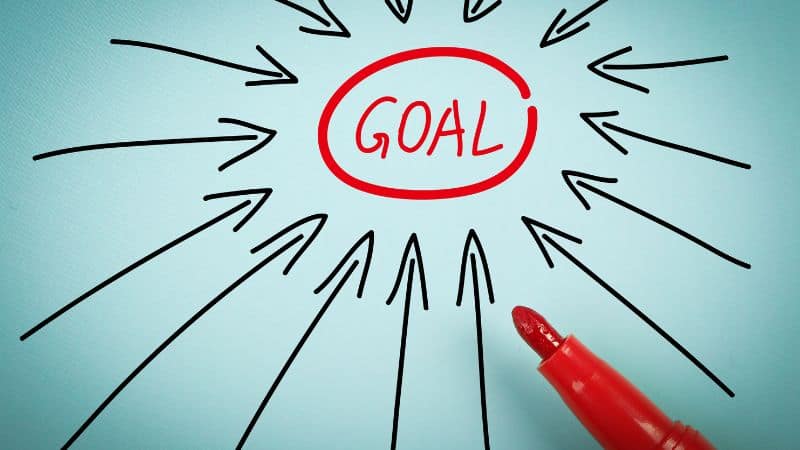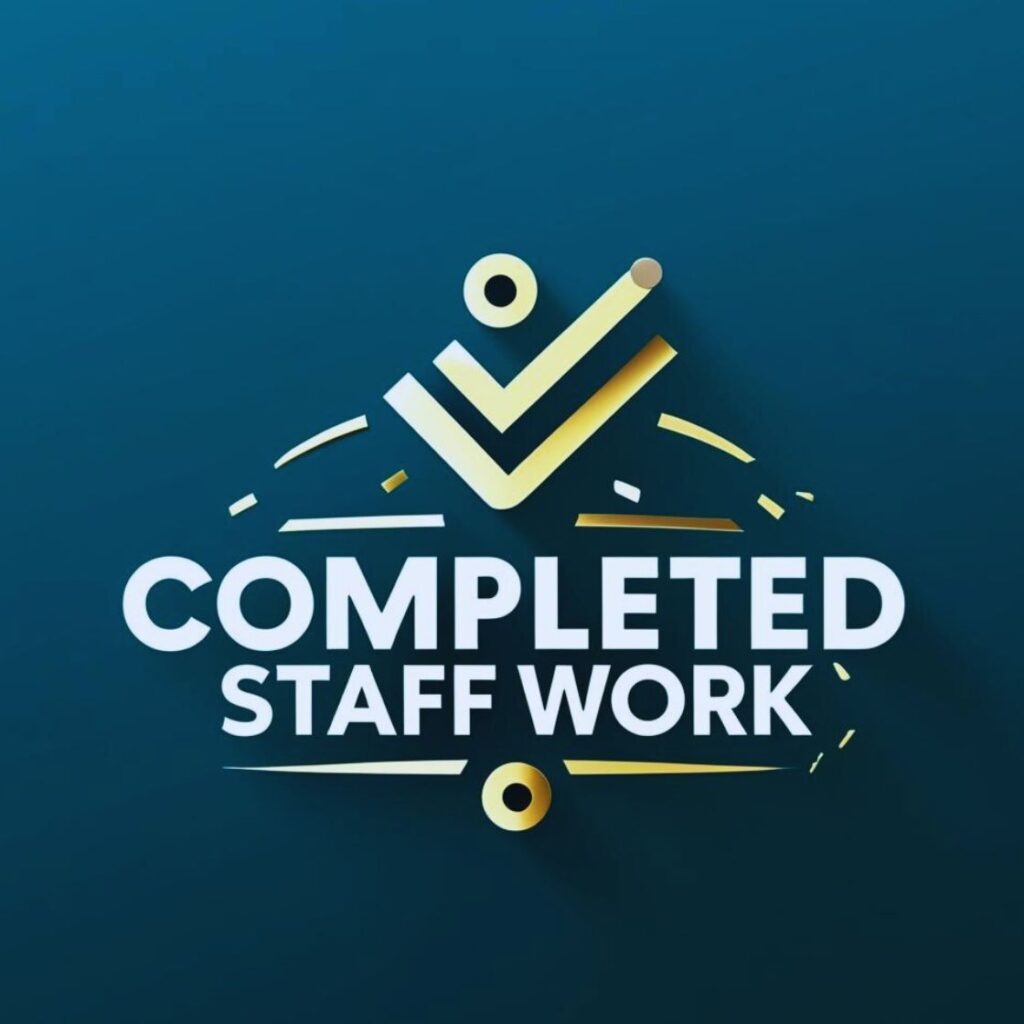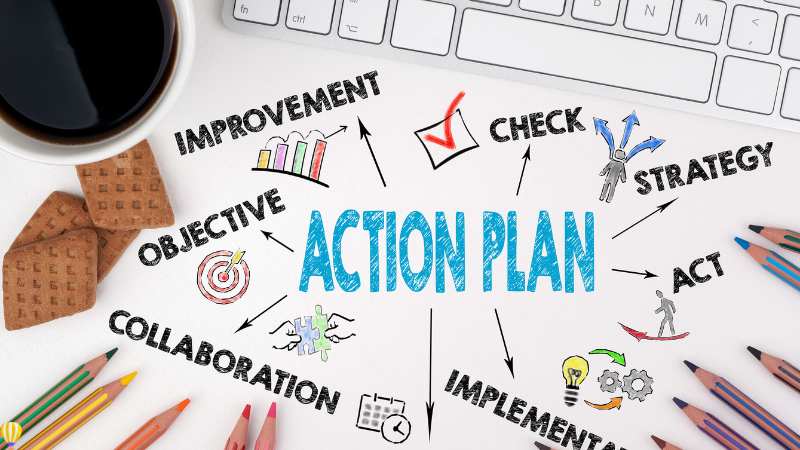In this guide, Jef Menguin encourages everyone to start creating a personal development plan to achieve personal success. The 4 steps are the simplified version of the Four Disciplines of Execution, which ensures you can make great things happen.
Leaders can use the same steps to help employees accomplish their professional development goals. You can follow the steps using his examples in writing a book on team building. You may also download the Make Great Happen Worksheet to help you get started.

What is a personal development plan?
A personal development plan is a design of your intention or decision on what you will do with your life. It is a lifelong process of growing, developing, reinventing, and transforming yourself. A personal development plan may contain everything you want to achieve in life. However, it can also be a specific design to improve an aspect of your life.
Some gurus promote personal development plans as a life blueprint. However many successful people admit that their development plans are products of many iterations, pivots, and recognizing new opportunities.
Workplace professionals use personal development plans for career development. But, unfortunately, only one in every ten people has a personal development plan.
It is a visual guide.
It can tell you about milestones and landmarks. But it won’t make you perfectly prepared; you have to adjust as you learn new things on your journey.
Therefore, it is a waste of time to overthink your personal development plan. It is not set in stone; it is dynamic and ever-changing.
A plan, no matter how well-thought cannot bring you anywhere without action. The personal development plan that I will teach you will move you from a dream to strategy, execution, and momentum.
So, congratulations. You are about to make good things happen in your life.

Personal Development Plan using 4DX
Ever felt lost amid a whirlwind of goals, tasks, and distractions? Well, you’re not alone. But the good news is, I’ve got a game-changer for you: the 4 Disciplines of Execution (4DX).
Created by Stephen R. Covey, Chris McChesney, and Sean Covey, 4DX is a business strategy tool used by companies all over the world to smash their most ambitious goals.
But guess what? It’s not just for businesses.
The principles of 4DX can be a game-changer in your personal life too. I’ve tweaked the 4DX framework to help fellow Filipinos craft effective personal development plans.
Wondering Why 4DX?
The magic of 4DX lies in its simplicity and effectiveness. It gives you a crystal-clear roadmap to reach your most important goals. It helps you zero in on what’s crucial, track how you’re doing, and keep you accountable for your actions.
In this guide, I’ll break down the 4DX framework into bite-sized, digestible pieces. You’ll learn how to craft your personal development plan using 4DX, and I’ll throw in some examples to help you see how you can apply these principles to your life.
Ready to dive in?
1. Identify Your Most Important Goals
The first step is to identify your Most Important Goals. These are one or two crucial objectives that you want to achieve in a specific period, such as the next six months or one year. It’s essential to choose goals that will have a significant impact on your life and advance a personal dream or purpose. These goals should be clear, measurable, achievable, but also meaningful and transformative.
Example: If one of your dreams is to inspire others, a Most Important Goal could be: “Deliver five 10-minute speeches confidently in front of a group of 50 people in the next three months.”
2. Determine Your Key Actions
Once you have identified your Most Important Goals, the next step is to determine the Key Actions required to achieve them. These are specific activities or tasks that you need to do regularly and are directly related to the achievement of your goals. These actions should be actionable, influenceable, and predictive of achieving your goal.
Example: For the goal of delivering five 10-minute speeches, your Key Actions could be: “Volunteer to speak during meetings”, “Join Toastmasters and participate in table topics and prepared speeches”, and “Craft speeches and rehearse even though there are no speaking opportunities yet”.
3. Track Your Progress
Tracking your progress is crucial for staying motivated and on track. Create a simple, visible way to track your progress on your Key Actions. This could be a chart on your wall, a spreadsheet, or an app on your phone. The important thing is that it is easy to update and regularly reminds you of your progress.
Example: For the public speaking goal, your Progress Tracker could be a calendar where you mark off each day that you volunteered to speak, attended Toastmasters meetings, participated in table topics prepared speeches, and crafted and rehearsed speeches.
4. Hold Yourself Accountable
Regularly review your progress, reflect on your efforts, and make any necessary adjustments to your plan. This is a time for honest self-assessment and recalibration if necessary. Setting up regular times (e.g., daily or weekly) for these check-ins will help you stay accountable and committed to your Most Important Goals.
Example: At the end of each week, review your calendar and reflect on your progress. Did you volunteer to speak? Did you attend Toastmasters meetings and participate in table topics and prepared speeches? Did you craft and rehearse speeches? What went well? What could you improve? Make any necessary adjustments for the following week.

Personal Development Plan Examples
I’m going to share four tales of everyday heroes who used the 4DX magic to craft killer personal development plans and transform their lives.
These aren’t just stories; they’re a roadmap. Each story is a practical example of how to nail down your important goals, map out your key moves, track your progress, and stay accountable.
By the end of these stories, you’ll see 4DX in a whole new light.
You’ll be pumped and ready to apply these principles to your personal development journey.
So, grab a comfy seat, maybe a cuppa if that’s your thing, and let’s dive into the world of 4DX through the lens of these four incredible journeys.
Marco, a Successful Regional Sales Manager
Meet Marco, a devoted father of three young children, who has been managing people successfully for over a decade.
However, life threw him a curveball when he was assigned a new role as a regional sales manager. This role was different from what he was used to and required a whole new set of skills.
Marco saw this as an opportunity to not only advance in his career but to provide a better life for his family. Inspired by his desire to be the best provider for his family, he decided to create a personal development plan using the 4DX framework.
Marco’s Big Goal
Marco had one big goal in mind: “Become proficient as a regional sales manager in six months.” This goal was more than just about his career; it was about being the best for his family.
Marco’s Action Steps
To achieve his big goal, Marco outlined several specific action steps:
- “Complete a sales training course in two months.”
- “Build relationships with at least five key stakeholders each month.”
- “Develop and implement a sales strategy for my region in three months.”
- “Seek feedback from my team and superiors at least once a month.”
Marco made sure each action step was something he could directly influence and was a strong indicator of making progress toward his big goal.
Marco’s Progress Journal
Marco created a progress journal to keep track of milestones for each action step. For example, he set mini-goals for completing each module of the sales training course and for the number of stakeholders he connected with each week.
Marco’s Accountability Ritual
Marco established a weekly ritual where he would review his progress, reflect on his efforts, and adjust his plan if needed. He also made it a point to seek feedback from his team and superiors regularly to ensure he was on the right path.
Marco faced several challenges along the way. The sales training course was tougher than he thought, and it was hard to find time for it while balancing work and family.
Also, building relationships with key stakeholders took more time than expected.
However, Marco stayed committed to his plan and his purpose.
He adjusted his schedule to make more time for the training course and connected with stakeholders through virtual meetings to save travel time. His hard work paid off.
By the end of six months, he had completed the sales training course, built strong relationships with key stakeholders, implemented a successful sales strategy for his region, and received positive feedback from his team and superiors.
Marco’s journey was not easy, but by creating a personal development plan and staying committed to his big goal and purpose, he overcame the challenges and succeeded in his new role as a regional sales manager. This success not only benefited his career but also helped him fulfill his purpose of providing a better life for his family.
Wilrose, the Value-Adding Professional
Meet Wilrose, a diligent working student who juggled online jobs as a writer and tutor, volunteered in her barangay and aimed to graduate Magna Cum Laude to help her family. Inspired by her desire to support her family and make a meaningful impact on her community, she created a personal development plan using the 4DX framework.
Wilrose’s Big Goal
Wilrose had a clear and ambitious goal: “Become a Magna Cum Laude while working and volunteering to support my family and community.”
This goal was not just about personal achievement; it was about contributing to her family and community meaningfully.
Wilrose’s Action Steps
To achieve her big goal, Wilrose outlined several specific action steps:
- “Dedicate at least 4 hours daily for studying and completing school assignments.”
- “Allocate time each week for writing and tutoring jobs without compromising my studies.”
- “Volunteer in my barangay for at least 2 hours every weekend.”
- “Maintain a weekly planner to manage my time effectively.”
Each of these action steps was designed to be directly under her control and strongly indicative of progress toward her big goal.
Wilrose’s Progress Journal
Wilrose kept a progress journal to monitor her milestones for each action step. For example, she tracked the hours spent studying, working, and volunteering each week. She also noted her academic achievements and any feedback from her online jobs or volunteer work.
Wilrose’s Accountability Ritual
Wilrose established a weekly ritual where she reviewed her progress, reflected on her efforts, and adjusted her plan as needed. She also sought feedback from her teachers, employers, and barangay officials to ensure she was making meaningful contributions in all areas of her life.
Wilrose faced several challenges along the way. Balancing her studies with work and volunteer commitments was incredibly tough. There were times when she felt overwhelmed and doubted if she could achieve her big goal.
However, Wilrose stayed committed to her plan and her purpose. She learned to manage her time more effectively, sought help when needed, and remained focused on her big goal. Her hard work and dedication paid off. Not only did she graduate Magna Cum Laude, but she also made meaningful contributions to her community and supported her family through her online jobs.
After graduating, Wilrose secured a position at a non-governmental organization (NGO) as a value-adding professional. She now uses her skills and knowledge to make a positive impact on her community and continues to support her family.
Wilrose’s journey was not easy, but by creating a personal development plan and staying committed to her big goal and purpose, she overcame the challenges and achieved success both personally and professionally. This success not only benefited her and her family but also had a positive impact on her community.
Jennie Who Helped Her Students Become Better Readers
Meet Jennie, a dedicated teacher in the Department of Education (DepEd) who was passionate about helping her students become better readers.
However, she faced a significant challenge – she was not an expert in reading. Determined to make a difference in her students’ lives, she decided to create a personal development plan using the 4DX framework.
Jennie’s Big Goal
Jennie’s big goal was clear: “Help my students improve their reading skills by the end of the school year.” This goal was not just about her professional development; it was about making a meaningful impact on her students’ lives.
Jennie’s Action Steps
To achieve her big goal, Jennie outlined several specific action steps:
- “Enroll in an online course on teaching reading skills within the next month.”
- “Implement new reading strategies learned from the course in my classroom each week.”
- “Dedicate at least 30 minutes daily for reading activities in my classroom.”
- “Regularly assess my students’ reading progress and adjust my teaching strategies as needed.”
Each of these action steps was designed to be directly under her control and strongly indicative of progress toward her big goal.
Jennie’s Progress Journal
Jennie kept a progress journal to monitor her milestones for each action step. For example, she tracked her progress in the online course, noted new strategies implemented in her classroom, and recorded her students’ reading progress.
Jennie’s Accountability Ritual
Jennie established a weekly ritual where she reviewed her progress, reflected on her efforts, and adjusted her plan as needed. She also sought feedback from her colleagues and students to ensure her teaching strategies were effective.
Jennie faced several challenges along the way. The online course was more demanding than she anticipated, and it was challenging to find the time to complete it while managing her teaching responsibilities. Also, some reading strategies were more effective for her students than others, requiring her to continuously adjust her approach.
However, Jennie stayed committed to her plan and her purpose. She completed the online course, implemented new reading strategies in her classroom, and dedicated time each day for reading activities. She also regularly assessed her students’ progress and adjusted her teaching strategies as needed.
By the end of the school year, Jennie’s hard work and dedication paid off. Her students showed significant improvement in their reading skills, and she received positive feedback from both her colleagues and her students’ parents.
Jennie’s journey was not easy, but by creating a personal development plan and staying committed to her big goal and purpose, she overcame the challenges and made a meaningful impact on her students’ lives. This success not only benefited her professionally but also helped her students develop essential reading skills that will serve them well in the future.
Marco, Wilrose, and Jennie faced distinct challenges: transitioning to a new role, balancing work, study, and volunteering, and enhancing students’ reading skills, respectively. Despite these hurdles, all three successfully utilized the 4DX framework to set clear goals, outline actionable steps, and maintain accountability. Their journeys underscore the critical lesson that with a well-structured plan, commitment to one’s goals, and the flexibility to adapt as needed, it is possible to overcome significant obstacles and achieve meaningful success.
No posts
Next Articles to Read
Continue your journey on personal development. I recommend the following articles.
- Personal Development Plan at Work. PDP is also called the Professional Development Plan. Your supervisors can help you map out your career development.
- Be Your Super-duper Best. When you pursue personal excellence, your mind will be opened to many possibilities.
- Personal Development Jump-Start Guide. This article provides you with practical advice on how you can pursue personal development and self-improvement.
- 50 Self-Improvement Tips. One of these can help you speed up your self-improvement pursuit.
- Self-development for Smart People. Be smart and be the person you want to be.
- 6 Important Aspects of Personal Development. You can improve every aspect of your life. May you find easy and simple ways by reading this article.
- Successful People Seek Personal Development. We succeed when we grow. Explore how and you will find the courage to make your next steps
- Uncover Your Blindspot in Personal Development. Celestine Chua gives excellent tips on how you can uncover your blind spots.
You can also explore these related topics.
- What Leadership Is. Find out how you can get started in leading people. This article is an excellent resource if you want to understand what you need to know and develop to become a leader that people wish to follow.
- Persuasive Speeches That Move People to Action. If you want to know how to make influence people, delivering persuasive speeches may help you.
- Growth Mindset versus Fixed Mindset. A growth mindset will help set you up for big-thinking projects. In addition, a growth mindset will help you set bold personal development plans.





